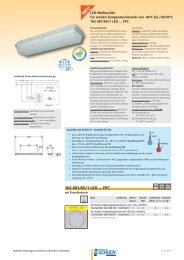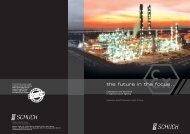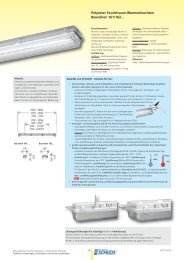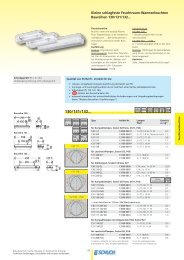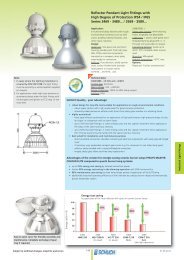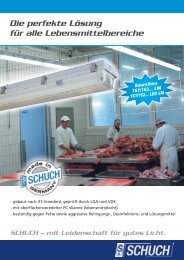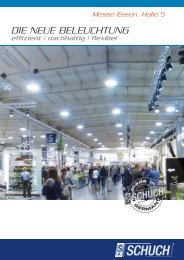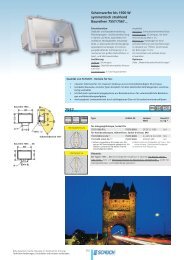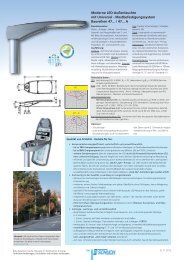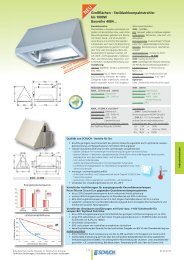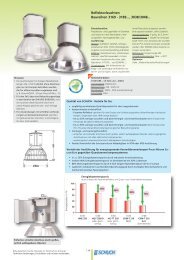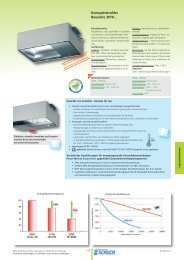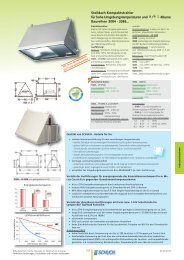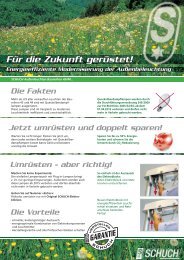- Page 2:
Table of Contents Explosionprotecte
- Page 5 and 6:
SCHUCH Explosion Protected Light Fi
- Page 7 and 8:
SCHUCH Explosion protcted Light Fit
- Page 9 and 10:
Explosion-proof Light Fittings Seri
- Page 11 and 12:
! Further Series / Equipment - sepa
- Page 13 and 14:
e841..././. II 2 G Ex d e q IIC T4
- Page 15 and 16:
Foto: BASF ! Further Series / Equip
- Page 17 and 18:
e846 ..././.. II 2 G Ex d e q IIC T
- Page 19 and 20:
Small Explosion-proof Sheet Steel E
- Page 21 and 22:
Explosion-proof Sheet Steel Light F
- Page 23 and 24:
! Further Series / Equipment - with
- Page 25 and 26:
e182.. II 2 G Ex d e q IIC T4 Gb II
- Page 27 and 28:
Explosion-proof Sheet Steel Light F
- Page 29 and 30:
Explosion-proof Light Fitting for l
- Page 31 and 32:
NEW Explosion-proof LED Floodlight
- Page 33 and 34:
Photo: BASF d3000... H.. II 2 G Ex
- Page 35 and 36:
d4000... H55 II 2 G Ex db eb IIC T4
- Page 37 and 38:
Explosion-Proof Handlamp for Incand
- Page 39 and 40:
Series nD 161... nD161/162… II 3
- Page 41 and 42:
Explosion-Protected Polyester Emerg
- Page 43 and 44:
NEW Explosion-proof Light Fittings
- Page 45 and 46:
Foto BASF Mounting material Suspens
- Page 47 and 48:
Mounting accessories Suspension bra
- Page 49 and 50:
nD848... for bi-pin fluorescent tub
- Page 51 and 52:
nD8611/201/. W LED LED Emergency/es
- Page 53 and 54:
Dimensions for recessed mounting Fr
- Page 55 and 56:
Dimensions of recessed installation
- Page 57 and 58:
Explosion-Protected Sheet Steel Lig
- Page 59 and 60:
Explosion-Protected Compact Sheet S
- Page 61 and 62:
Explosion-Protected Plane Surface F
- Page 63 and 64:
Floodlight for Lamps up to 500W for
- Page 65 and 66:
Aluminium Carrier Rails for Continu
- Page 67 and 68:
Explosion-Protected Wall Socket Sys
- Page 69 and 70:
Explosion-Protected Installation Sw
- Page 71 and 72:
Explosion-Protected Lamp Holder G13
- Page 73 and 74:
Damp Room Light Fittings Designing
- Page 75 and 76:
SCHUCH dustproof/water-proof light
- Page 77 and 78:
Dustproof/Waterproof Polyester Ligh
- Page 79 and 80:
NEW 161/162… F RLED for LED Retro
- Page 81 and 82:
Note: Depending on lamp length (549
- Page 83 and 84:
Note: The light fitting is not to b
- Page 85 and 86:
Note: Especially for the food indus
- Page 87 and 88:
NEW Dustproof/Waterproof Polyester
- Page 89 and 90:
Damp Room Polyester Light Fittings
- Page 91 and 92:
Note: Application of VDE tested LED
- Page 93 and 94:
Note: For avoiding any formation of
- Page 95 and 96:
Compact Polyester Damp Room Light F
- Page 97 and 98:
164... KL S. with high polished mir
- Page 99 and 100:
NEW 130/131... W LED with Highpower
- Page 101 and 102:
Polyester Damp Room Light Fitting w
- Page 103 and 104:
175… S38 with clear PC protective
- Page 105 and 106:
Accessories / Spare Parts for Serie
- Page 107 and 108:
176 ... S50 (T5) IP65 with clear PC
- Page 109 and 110:
! Further Series / Equipment - with
- Page 111 and 112:
192... surface and flush mounting l
- Page 113 and 114:
! Further Series / Equipment - up t
- Page 115 and 116:
182... surface and flush mounting l
- Page 117 and 118:
181/182... SSK for blasting areas a
- Page 119 and 120:
Sheet Steel Light Fittings for Room
- Page 121 and 122:
Compact Sheet Steel Light Fittings
- Page 123 and 124:
Light Fittings for Motor Vehicle Pi
- Page 125 and 126:
Series 140 1... SB symmetrical / ce
- Page 127 and 128:
! Further Series / Equipment - in i
- Page 129 and 130:
Sheet steel Carrier Rails for Conti
- Page 131 and 132:
Industrial Light Fittings Power sta
- Page 133 and 134:
SCHUCH-Industrieleuchten funktionie
- Page 135 and 136:
Reflector Light Fittings Series 316
- Page 137 and 138:
3169 - 3189... IFS for applications
- Page 139 and 140:
Reflector Pendant Light Fittings wi
- Page 141 and 142:
NEW 3521 - 3551... Z For areas with
- Page 143 and 144:
! Further Series / Versions - with
- Page 145 and 146:
3469 - 3489… IP54, with safety gl
- Page 147 and 148:
3469 - 3489... Z, 3569 - 3589... Z
- Page 149 and 150:
3469 - 3489... IFS, 3569 - 3589...
- Page 151 and 152:
3588… H90 for high ambient temper
- Page 153 and 154:
Reflector Light Fittings with Induc
- Page 155 and 156:
Note: 1. The light fitting series f
- Page 157 and 158:
3070… high bay light fittings HME
- Page 159 and 160:
3070… SB with extreme wide beam r
- Page 161 and 162:
3070... IFS for applications in foo
- Page 163 and 164:
Wide Area - Compact Flood Lights up
- Page 165 and 166:
3170… Z for areas with high dust
- Page 167 and 168:
Note: Also available for high press
- Page 169 and 170:
3084 - 3085... IFS for applications
- Page 171 and 172:
3084... SSK for sand blasting locat
- Page 173 and 174:
4084… narrow-wide beam IP65 HME H
- Page 175 and 176:
! Further Series / Versions - safet
- Page 177 and 178:
Compact Light Fitting for Extreme I
- Page 179 and 180:
Floodlight for Sand Blasting Areas
- Page 181 and 182:
3031... Tiefstrahler HIT HST HIT-CE
- Page 183 and 184:
3021/3031… V für den Einsatz in
- Page 185 and 186:
3021/3031... AF for areas with high
- Page 187 and 188:
Compact Light Fitting for Greenhous
- Page 189 and 190:
Ceiling and Wall Mounting Light Fit
- Page 191 and 192:
3610… Ceiling / Wall mounting lig
- Page 193 and 194:
Industrial Industrieleuchten Light
- Page 195 and 196:
SCHUCH Outdoor Light Fittings NEW N
- Page 197 and 198:
Outdoor Außenleuchten Light fittin
- Page 199 and 200:
Outdoor Außenleuchten Light fittin
- Page 201 and 202:
47... LED IP65 LPH 4-12m LED Type A
- Page 203 and 204:
46/46AL... LED IP65 LPH 4-6m Wind l
- Page 205 and 206:
46/46AL... FG with flat safety glas
- Page 207 and 208:
Conventional Outdoor Light Fitting
- Page 209 and 210:
43... IP65 Lamp comp. IP43 Connecti
- Page 211 and 212:
! NEW Further Series / Equipment -
- Page 213 and 214:
Polyester Outdoor Light Fitting wit
- Page 215 and 216:
standardized by Deutsche Bahn AG 44
- Page 217 and 218:
! Further Series / Equipment - with
- Page 219 and 220:
! Further Series / Equipment - with
- Page 221 and 222:
! Further Series / Equipment - insu
- Page 223 and 224:
287… S (T5) with mirror reflector
- Page 225 and 226:
541 1701 LED/. with highpower LED I
- Page 227 and 228:
! Further Series / Equipment NEW -
- Page 229 and 230:
543/2402 LED/. indirect light Appli
- Page 231 and 232:
543/1701 LED/. lighting from above
- Page 233 and 234:
Classical Post-Top Light Fittings S
- Page 235 and 236: Spherical-type Light Fitting Series
- Page 237 and 238: Small decorative Pendant Luminaire
- Page 239 and 240: Large decorative Pendant Luminaire
- Page 241 and 242: ! NEW 565… K S with clear glass a
- Page 243 and 244: NEW 7571/... LED/A LED IP65 LPH 3-6
- Page 245 and 246: NEW 7572/... LED/A LED IP65 LPH 6m
- Page 247 and 248: 7573... asymmetrical luminous radia
- Page 249 and 250: Asymmetrical Plane Floodlight for L
- Page 251 and 252: Compact Symmetrical Plane Floodligh
- Page 253 and 254: Symmetrical Floodlight for lamps up
- Page 255 and 256: ! Further Series / Equipment - with
- Page 257 and 258: 7567… IP55 Wind load area A = 0,1
- Page 259 and 260: Floodlights for Lamps up to 2000 W
- Page 261 and 262: Assembly Unit for Installation Insi
- Page 263 and 264: Cast Aluminium Multi-Purpose Pole A
- Page 265 and 266: Außenleuchten Bitte Technical beac
- Page 267 and 268: NEW NEW 161/162... ZB 163/164... ZB
- Page 269 and 270: 161/162.../I/... EVG with self-cont
- Page 271 and 272: Polyester Damp Room Emergency Light
- Page 273 and 274: ! Further series / equipment - poly
- Page 275 and 276: 164... KL LED/. MA with self-contai
- Page 277 and 278: Small Impact Resistant Emergency/Es
- Page 279 and 280: NEW 131... ZB for connection to cen
- Page 281 and 282: NEW 175... ZB for connection to cen
- Page 283 and 284: Emergency Notleuchten Light Fitting
- Page 285: SCHUCH - Technical Supplement Tempe
- Page 289: Summary of the products 3532 IFS...



